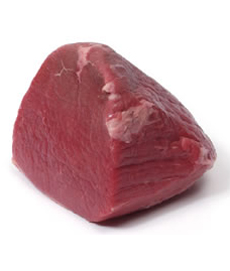Beef Glossary: A Glossary Of The Different Beef Types & Beef Cuts DiagramPage 6: Types Of Beef Terms & Definitions Q To R This is Page 6 of an 8-page article. Click on the red links below to visit other pages. This glossary is protected by copyright and cannot be reproduced in whole or part. You are welcome to link to it.
|
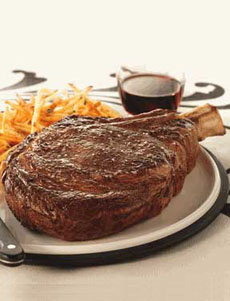 A juicy prime ribeye steak, available from Allen Brothers. |
|
|
If you’re looking for the definition of a particular cut of beef, you’ve come to the right place. Here’s the lingo butchers and other industry professionals use as they cut beef. (If you’d like to suggest additional words, click here.) On this page of the glossary, you’ll find terms such as aged beef, beef bacon, beef cheeks, beef jerky, beef stew meat, Black Angus beef and an answer to the question, What is beef? When looking up beef cuts, it’s helpful to refer to the beef cut diagram, courtesy of the National Cattleman’s Beef Association. If you enjoy this Beef Glossary, we have a food glossary for almost every category of food—including a Lamb Glossary and a Pork Glossary. 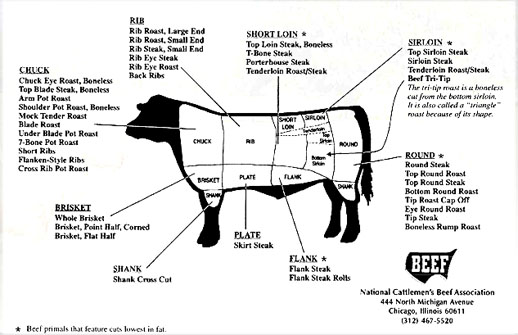
Download your own beef cuts chart (pdf).
|
||
| QUALITY GRADING Quality grades help predict the expected palatability of beef. The grade is based primarily on two factors: the amount of marbling in the rib eye muscle and the age of the animal. These can be adjusted for other factors such as the color of the lean beef. The USDA Quality Grades are: Prime, Choice, Select, Standard, Commercial, Utility, Cutter and Canner. Each grade denotes a specific level of quality that is determined by the USDA Grading Service.
|
||
| RED MEAT Red meats include beef, lamb, pork and veal.
|
||
| RIB CUTS Cuts from the rib portion of the cow are a great combination of both flavor and tenderness. They are an excellent choice for grilling and broiling. The steaks that come from the rib are rib steak and rib eye (see below). Other cuts from the rib includebaby back ribs, rib roasts and short ribs. The rib steak is a rich and juicy steak cut from the rib section of the steer, and it contains a section of the rib bone. It has a generous amount of fat, and frequently has more marbling than a top loin, which provides the excellent flavor. The rib eye steak was tradionally the boneless version of the rib steak, but today’s terminology calls them both rib eye, with the clarification of bone in or bone out/boneless. WANT THAT STEAK ON THE GRILL? SEE THESE STEAK-GRILLING TIPS
|
||
| RIB-EYE or RIBEYE STEAK Also known as the beauty steak, c ôte de boeuf (with bone in), cowboy steak (with bone in), Delmonico and Spencer steak, this flavorful, cut of prime rib (i.e., a boneless rib steak) is a favorite of steak lovers. Due to its rich marbling of fat, it is one of the most flavorful and juicy of steaks. It is also only a little less tender than the tenderloin, while adding a lot more flavorful because of the rich marbling. Ordering with the bone in makes it more succulent. In its uncut form, the rib eye is known as the rib roast (prime rib). See also rib cuts.
|
||
| RIB-EYE CAP
The tastiest and tenderest portion of the rib-eye, this is the well-marbled, crescent-shaped outer rim of the rib eye (in the photo, on the left side of the steaks). It’s a rib-eye lover’s favorite part of the steak.
|
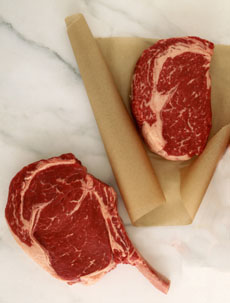 Rib-eye steaks, shown bone in and bone out. The cap is the cresent-shaped outer rim. Photo courtesy of Morton’s The Steakhouse. |
|
| RIB ROAST A beef roast from the rib section between the chuck and the short loin. The three most popular styles are standing rib roast, rolled rib roast and rib-eye roast. The standing rib roast usually includes at least three ribs (less than that is really just a very thick steak). It’s roasted standing upright, resting on its rack of ribs, thereby allowing the top layer of fat to melt and self-baste the meat. A rolled rib roast has had the bones removed before being rolled and tied into a cylinder. The boneless rib-eye roast is the center, most desirable and tender portion, and most expensive portion of the rib section. A prime rib roast is the finest quality rib roast, USDA Prime, available only from top butchers. |
||
| ROAST
A multi-pound piece of meat, generally cooked via radiant heat in an oven and sliced into multiple portions. Before modern ovens, roasts were cooked on a spit over a fire. Roasts are cut from almost every area along the top of the steer: chuck roast, rib roast, chateaubriand (from the short loin), sirloin tip roast, top round roast, eye of the round roast and rump roast (round). Roasts are best served medium rare to medium (the internal temperature on a meat thermometer should be 150°F to 155°F at serving time). Always take a roast out of the oven when it is at least 10 degrees below serving temperature and let it rest for 10 to 15 minutes before carving. “R” IS FOR RECIPES
|
 A prime rib roast, available from Allen Brothers. |
|
| ROUND
The round is the hind section of the beef. Since the rear of the animal has been toughened by exercise, the round is less tender than the rib, short loin and sirloin cuts. However, many steak lovers feel that it offers the best combination of texture and flavor. Cuts from the round include bottom round, cube steak, eye of the round, top round, round tip and rump steak.
|
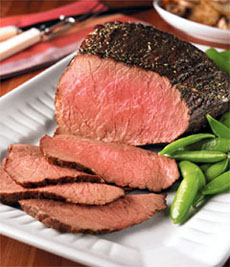 Top round roast. Photo courtesy GlacierBeef.com.
|
|
| RUMP ROAST The rump is a flavorful, triangular cut of meat taken from the upper part of the round. It is generally cut, boned and rolled into two or three rump roasts that. When the bone is left in, the cut is referred to as a standing rump roast.
Go To Next Page, Terms Beginning With S Go To Glossary Alphabet Index, Above
|
||
|
Lifestyle Direct, Inc. Some definitions were provided by the Cattlemen’s Beef Board and are © Copyright 2005 Cattlemen’s Beef Board. All rights reserved. Images are the copyright of their respective owners. |
||
Last Updated Apr 2018
© Copyright 2005-2025 Lifestyle Direct, Inc. All rights reserved. All images are copyrighted to their respective owners.
